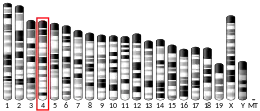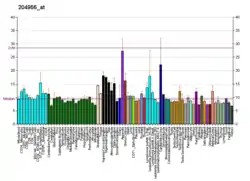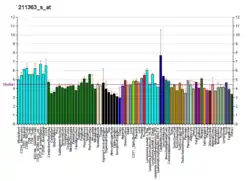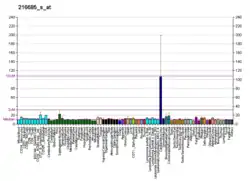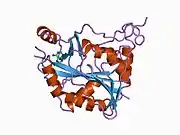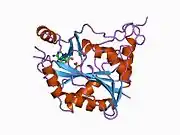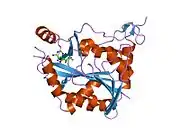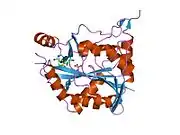| MTAP | |||||||||||||||||||||||||||||||||||||||||||||||||||
|---|---|---|---|---|---|---|---|---|---|---|---|---|---|---|---|---|---|---|---|---|---|---|---|---|---|---|---|---|---|---|---|---|---|---|---|---|---|---|---|---|---|---|---|---|---|---|---|---|---|---|---|
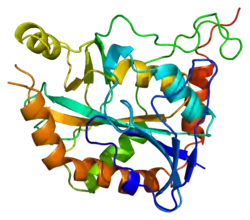 | |||||||||||||||||||||||||||||||||||||||||||||||||||
| |||||||||||||||||||||||||||||||||||||||||||||||||||
| Identifiers | |||||||||||||||||||||||||||||||||||||||||||||||||||
| Aliases | MTAP, BDMF, DMSFH, DMSMFH, HEL-249, LGMBF, MSAP, c86fus, methylthioadenosine phosphorylase | ||||||||||||||||||||||||||||||||||||||||||||||||||
| External IDs | OMIM: 156540 MGI: 1914152 HomoloGene: 1838 GeneCards: MTAP | ||||||||||||||||||||||||||||||||||||||||||||||||||
| |||||||||||||||||||||||||||||||||||||||||||||||||||
| |||||||||||||||||||||||||||||||||||||||||||||||||||
| |||||||||||||||||||||||||||||||||||||||||||||||||||
| |||||||||||||||||||||||||||||||||||||||||||||||||||
| |||||||||||||||||||||||||||||||||||||||||||||||||||
| Wikidata | |||||||||||||||||||||||||||||||||||||||||||||||||||
| |||||||||||||||||||||||||||||||||||||||||||||||||||
S-methyl-5'-thioadenosine phosphorylase (MTAP) is an enzyme in humans responsible for polyamine metabolism. It is encoded by the methylthioadenosine phosphorylase (MTAP) gene on chromosome 9.[5] Multiple alternatively spliced transcript variants have been described for this gene, but their full-length natures remain unknown.[6]
This gene encodes an enzyme that plays a major role in polyamine metabolism and is important for the salvage of both adenine and methionine. It is responsible for the first step in this pathway, where it catalyzes the reversible phosphorylation of MTA to adenine and 5-methylthioribose-1-phosphate. This takes place after MTA is generated from S-adenosylmethionine.[5]

MTAP was identified for the first time and characterized likely as a phosphorylase in 1969 by Pegg and Williams-Ashman.[7] The first purification that allowed characterization was by a group in 1986.[8] This purification allowed researchers to investigate why there is the lower expression of MTAP in some types of cancer.
Increased levels of MTA in tumor cells along with lower expression of MTAP.[9] The enzyme is deficient in many cancers because this gene and the tumor-suppressive p16 gene are co-deleted.[9][10][11][12][13]
Gene
The MTAP gene location is 9p21.3 which is chromosome 9, p arm, band 2, sub-band1, and sub-sub-band 3.[14][15] The MTAP gene has seven isomers which are created when mRNA’s of the same locus have different transcription start sites.[16] Due to the nature of the MTAP gene and the surrounding genes of chromosome 9, deletion of the genes around p21, and gene p21 are common.[17] Particularly the deletion of the gene p16 in conjunction with the whole or partial deletion of MTAP has been indicated in some cancer types.[17] Genes p15 and p16 of chromosome nine are closely linked to the MTAP gene, because of this, MTAP is commonly cross-deleted.[10][11][17] This deletion is found in many cancerous tissues.[10][11]
Structure
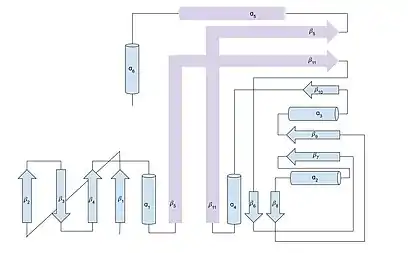
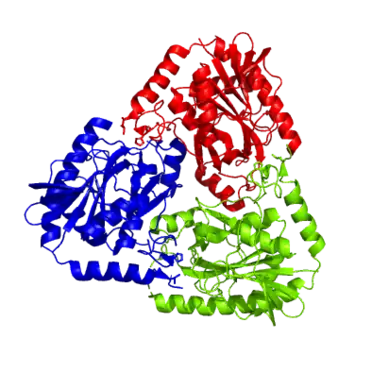
MTAP is a trimer enzyme that shares a similar structure and functions with mammalian purine nucleoside phosphorylases (PNPs) which are also trimeric enzymes.[18] MTAP’s subunits are identical in structure and composed of 283 amino acid residues that form to the size of about 32 kDa each.[8][18] The main structure of an MTAP subunit consists of eleven beta-sheets with six alpha-helices intermixed.[18] The active site of the enzyme is made up of beta-sheets five and 11, as well as alpha-helix 5, and four separate residue loop structures.[18] Within MTAP, helix six is a 12-residue C-terminal helix that arranges for the leucine residue 279 of one subunit to be a part of the active site of another subunit.[18] The active site of each subunit includes two residues (His137 and Leu279) from a neighboring subunit, relying on the interactions between the subunits for proper enzymatic activity.[18] MTAP contains an active site with three regions that correspond to a base, methylthioribose, and sulfate/phosphate binding site.[18]
Function
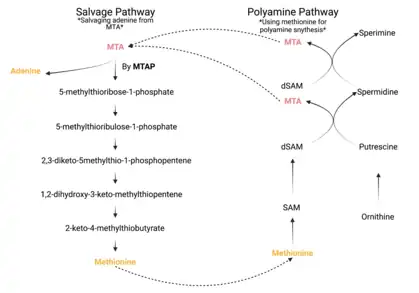
S-methyl-5'-thioadenosine phosphorylase, MTAP, primarily functions to salvage adenine and methionine from molecule methylthioadenosine (MTA), a byproduct of the polyamine pathway. MTAP is a phosphorylase, which is an enzyme that catalyzes the addition of an inorganic phosphate to another molecule. MTAP is responsible for the cleaving of its substrate, MTA, into adenine and 5-methylthioribose-1-phosphate by the addition of the inorganic phosphate to the 1-prime carbon of the ribose sugar unit MTA.[18] The 5-methylthioribose-1-phosphate is then cycled into the salvage pathway and metabolized into methionine.[20][21] The MTAP enzyme is responsible for nearly all the adenine synthesis in the human body.[18] Adenine is one of the purine bases of nucleic acids, which build both DNA and RNA. Through the recovery of adenine, MTAP plays a highly critical indirect role in the synthesis of DNA and RNA.
Cancer
In recent years a connection between tumor growth, cancer developments, and the enzyme MTAP. Research studies show that tumor cells have lower expression of MTAP enzymes and a higher concentration of the MTA molecule.[9] This trend can be easily understood through the polyamine pathway where MTAP functions to cleave its substrate MTA.[9][22] In healthy cells, the molecule MTA is believed to have tumor suppressing properties and regulate cell proliferation.[22] However, when MTA levels were recorded above optimal working conditions, these MTA molecules appeared to have an inverse relation, promoting tumor growth and significantly increasing the proliferation of tumor cells.[9] These increased levels of MTA in tumor cells is in direct correlation to a down regulation or complete deletion of the gene encoding the MTAP enzyme.[9]
References
- 1 2 3 GRCh38: Ensembl release 89: ENSG00000099810 - Ensembl, May 2017
- 1 2 3 GRCm38: Ensembl release 89: ENSMUSG00000062937 - Ensembl, May 2017
- ↑ "Human PubMed Reference:". National Center for Biotechnology Information, U.S. National Library of Medicine.
- ↑ "Mouse PubMed Reference:". National Center for Biotechnology Information, U.S. National Library of Medicine.
- 1 2 3 "MTAP - S-methyl-5'-thioadenosine phosphorylase - Homo sapiens (Human) - MTAP gene & protein". www.uniprot.org. Retrieved 2021-12-03.
- ↑ "MTAP methylthioadenosine phosphorylase [Homo sapiens (human)] - Gene - NCBI". www.ncbi.nlm.nih.gov. Retrieved 2021-12-03.
- ↑ Pegg AE, Williams-Ashman HG (November 1969). "Phosphate-stimulated breakdown of 5'-methylthioadenosine by rat ventral prostate". The Biochemical Journal. 115 (2): 241–247. doi:10.1042/bj1150241. PMC 1185095. PMID 5378381.
- 1 2 Della Ragione F, Cartenì-Farina M, Gragnaniello V, Schettino MI, Zappia V (September 1986). "Purification and characterization of 5'-deoxy-5'-methylthioadenosine phosphorylase from human placenta". The Journal of Biological Chemistry. 261 (26): 12324–12329. doi:10.1016/S0021-9258(18)67242-4. PMID 3091600.
- 1 2 3 4 5 6 Kirovski G, Stevens AP, Czech B, Dettmer K, Weiss TS, Wild P, et al. (March 2011). "Down-regulation of methylthioadenosine phosphorylase (MTAP) induces progression of hepatocellular carcinoma via accumulation of 5'-deoxy-5'-methylthioadenosine (MTA)". The American Journal of Pathology. 178 (3): 1145–1152. doi:10.1016/j.ajpath.2010.11.059. PMC 3069916. PMID 21356366.
- 1 2 3 Barekatain Y, Ackroyd JJ, Yan VC, Khadka S, Wang L, Chen KC, et al. (July 2021). "Homozygous MTAP deletion in primary human glioblastoma is not associated with elevation of methylthioadenosine". Nature Communications. 12 (1): 4228. Bibcode:2021NatCo..12.4228B. doi:10.1038/s41467-021-24240-3. PMC 8270912. PMID 34244484.
- 1 2 3 Menezes WP, Silva VA, Gomes IN, Rosa MN, Spina ML, Carloni AC, et al. (February 2020). "Loss of 5'-Methylthioadenosine Phosphorylase (MTAP) is Frequent in High-Grade Gliomas; Nevertheless, it is Not Associated with Higher Tumor Aggressiveness". Cells. 9 (2): 492. doi:10.3390/cells9020492. PMC 7072758. PMID 32093414.
- ↑ Xu J, Chang WH, Fong LW, Weiss RH, Yu SL, Chen CH (2019-01-25). "Targeting the insulin-like growth factor-1 receptor in MTAP-deficient renal cell carcinoma". Signal Transduction and Targeted Therapy. 4: 2. doi:10.1038/s41392-019-0035-z. PMC 6345872. PMID 30701095.
- ↑ Hansen LJ, Sun R, Yang R, Singh SX, Chen LH, Pirozzi CJ, et al. (July 2019). "MTAP Loss Promotes Stemness in Glioblastoma and Confers Unique Susceptibility to Purine Starvation". Cancer Research. 79 (13): 3383–3394. doi:10.1158/0008-5472.CAN-18-1010. PMC 6810595. PMID 31040154.
- ↑ "MTAP Gene". www.genecards.org. Retrieved 2021-10-06.
- ↑ "MLA CE Course Manual: Molecular Biology Information Resources (Genetics Review: Chromosome Band Numbers)". www.ncbi.nlm.nih.gov. Retrieved 2021-10-06.
- ↑ "UniProtKB - Q13126 (MTAP_Human)". UniProt. Retrieved October 5, 2021.
- 1 2 3 Nobori T, Takabayashi K, Tran P, Orvis L, Batova A, Yu AL, Carson DA (June 1996). "Genomic cloning of methylthioadenosine phosphorylase: a purine metabolic enzyme deficient in multiple different cancers". Proceedings of the National Academy of Sciences of the United States of America. 93 (12): 6203–6208. Bibcode:1996PNAS...93.6203N. doi:10.1073/pnas.93.12.6203. PMC 39214. PMID 8650244.
- 1 2 3 4 5 6 7 8 9 10 Appleby TC, Erion MD, Ealick SE (June 1999). "The structure of human 5'-deoxy-5'-methylthioadenosine phosphorylase at 1.7 A resolution provides insights into substrate binding and catalysis". Structure. 7 (6): 629–641. doi:10.1016/S0969-2126(99)80084-7. PMID 10404592.
- ↑ Bank, RCSB Protein Data. "RCSB PDB - 3OZE: Crystal Structure of human 5'-deoxy-5'-methyladenosine phosphorylase". www.rcsb.org. Retrieved 2021-12-02.
- 1 2 Subhi AL, Diegelman P, Porter CW, Tang B, Lu ZJ, Markham GD, Kruger WD (December 2003). "Methylthioadenosine phosphorylase regulates ornithine decarboxylase by production of downstream metabolites". The Journal of Biological Chemistry. 278 (50): 49868–49873. doi:10.1074/jbc.M308451200. PMID 14506228.
- ↑ Bertino JR, Waud WR, Parker WB, Lubin M (April 2011). "Targeting tumors that lack methylthioadenosine phosphorylase (MTAP) activity: current strategies". Cancer Biology & Therapy. 11 (7): 627–632. doi:10.4161/cbt.11.7.14948. PMC 3084968. PMID 21301207.
- 1 2 Li Y, Wang Y, Wu P (January 2019). "5'-Methylthioadenosine and Cancer: old molecules, new understanding". Journal of Cancer. 10 (4): 927–936. doi:10.7150/jca.27160. PMC 6400808. PMID 30854099.
Further reading
- Carrera CJ, Eddy RL, Shows TB, Carson DA (May 1984). "Assignment of the gene for methylthioadenosine phosphorylase to human chromosome 9 by mouse-human somatic cell hybridization". Proceedings of the National Academy of Sciences of the United States of America. 81 (9): 2665–2668. Bibcode:1984PNAS...81.2665C. doi:10.1073/pnas.81.9.2665. PMC 345130. PMID 6425836.
- Olopade OI, Pomykala HM, Hagos F, Sveen LW, Espinosa R, Dreyling MH, et al. (July 1995). "Construction of a 2.8-megabase yeast artificial chromosome contig and cloning of the human methylthioadenosine phosphorylase gene from the tumor suppressor region on 9p21". Proceedings of the National Academy of Sciences of the United States of America. 92 (14): 6489–6493. Bibcode:1995PNAS...92.6489O. doi:10.1073/pnas.92.14.6489. PMC 41543. PMID 7604019.
- Della Ragione F, Takabayashi K, Mastropietro S, Mercurio C, Oliva A, Russo GL, et al. (June 1996). "Purification and characterization of recombinant human 5'-methylthioadenosine phosphorylase: definite identification of coding cDNA". Biochemical and Biophysical Research Communications. 223 (3): 514–519. doi:10.1006/bbrc.1996.0926. PMID 8687427.
- Gursky S, Olopade OI, Rowley JD (September 2001). "Identification of a 1.2 Kb cDNA fragment from a region on 9p21 commonly deleted in multiple tumor types". Cancer Genetics and Cytogenetics. 129 (2): 93–101. doi:10.1016/S0165-4608(01)00444-7. PMID 11566337.
- Christopher SA, Diegelman P, Porter CW, Kruger WD (November 2002). "Methylthioadenosine phosphorylase, a gene frequently codeleted with p16(cdkN2a/ARF), acts as a tumor suppressor in a breast cancer cell line". Cancer Research. 62 (22): 6639–6644. PMID 12438261.
- Bornhauser BC, Olsson PA, Lindholm D (September 2003). "MSAP is a novel MIR-interacting protein that enhances neurite outgrowth and increases myosin regulatory light chain". The Journal of Biological Chemistry. 278 (37): 35412–35420. doi:10.1074/jbc.M306271200. PMID 12826659.
- Behrmann I, Wallner S, Komyod W, Heinrich PC, Schuierer M, Buettner R, Bosserhoff AK (August 2003). "Characterization of methylthioadenosin phosphorylase (MTAP) expression in malignant melanoma". The American Journal of Pathology. 163 (2): 683–690. doi:10.1016/S0002-9440(10)63695-4. PMC 1868213. PMID 12875987.
- Beausoleil SA, Jedrychowski M, Schwartz D, Elias JE, Villén J, Li J, et al. (August 2004). "Large-scale characterization of HeLa cell nuclear phosphoproteins". Proceedings of the National Academy of Sciences of the United States of America. 101 (33): 12130–12135. Bibcode:2004PNAS..10112130B. doi:10.1073/pnas.0404720101. PMC 514446. PMID 15302935.
- Bataille F, Rogler G, Modes K, Poser I, Schuierer M, Dietmaier W, et al. (January 2005). "Strong expression of methylthioadenosine phosphorylase (MTAP) in human colon carcinoma cells is regulated by TCF1/[beta]-catenin". Laboratory Investigation; A Journal of Technical Methods and Pathology. 85 (1): 124–136. doi:10.1038/labinvest.3700192. PMID 15492751.
- Berasain C, Hevia H, Fernández-Irigoyen J, Larrea E, Caballería J, Mato JM, et al. (November 2004). "Methylthioadenosine phosphorylase gene expression is impaired in human liver cirrhosis and hepatocarcinoma". Biochimica et Biophysica Acta (BBA) - Molecular Basis of Disease. 1690 (3): 276–284. doi:10.1016/j.bbadis.2004.08.002. hdl:10171/21382. PMID 15511635.
- Subhi AL, Tang B, Balsara BR, Altomare DA, Testa JR, Cooper HS, et al. (November 2004). "Loss of methylthioadenosine phosphorylase and elevated ornithine decarboxylase is common in pancreatic cancer". Clinical Cancer Research. 10 (21): 7290–7296. doi:10.1158/1078-0432.CCR-04-0972. PMID 15534104.
- Hustinx SR, Hruban RH, Leoni LM, Iacobuzio-Donahue C, Cameron JL, Yeo CJ, et al. (January 2005). "Homozygous deletion of the MTAP gene in invasive adenocarcinoma of the pancreas and in periampullary cancer: a potential new target for therapy". Cancer Biology & Therapy. 4 (1): 83–86. doi:10.4161/cbt.4.1.1380. PMID 15662124.
- Hustinx SR, Leoni LM, Yeo CJ, Brown PN, Goggins M, Kern SE, et al. (July 2005). "Concordant loss of MTAP and p16/CDKN2A expression in pancreatic intraepithelial neoplasia: evidence of homozygous deletion in a noninvasive precursor lesion". Modern Pathology. 18 (7): 959–963. doi:10.1038/modpathol.3800377. PMID 15832197.
- Hellerbrand C, Mühlbauer M, Wallner S, Schuierer M, Behrmann I, Bataille F, et al. (January 2006). "Promoter-hypermethylation is causing functional relevant downregulation of methylthioadenosine phosphorylase (MTAP) expression in hepatocellular carcinoma". Carcinogenesis. 27 (1): 64–72. doi:10.1093/carcin/bgi201. PMID 16081515.


